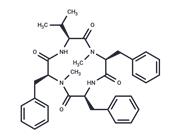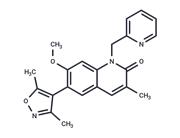| Name | Istradefylline |
| Description | Istradefylline (KW-6002)(Ki of 2.2 nM) is a selective adenosine A2A receptor (A2AR) antagonist, which is under development in Phase 3 trails. It has been used in trials studying the treatment and basic science of Drug Abuse, Sleep Disorder, Hepatic Impairment, Parkinson's Disease, and Restless Legs Syndrome, among others. |
| Cell Research | A CHO cell line permanently expressing the human adenosine A1or A2A?receptor is cultured in α-MEM supplemented with 10% (v/v) fetal bovine serum, 50 U/mL penicillin, and 50 μg/mL streptomycin. Cells are grown at 37°C in an environment of 5% CO2. These cells are seeded on black 96-well assay plates at a density of 15,000 cells/well, and then they are cultured for 24 h. |
| In vitro | The affinity of Istradefylline for the A2AR is 70-fold greater than that for the A1 receptor with Ki of 2.2 nM versus 150 nM. [1] Exposure of primary rat striatal astrocytes to Istradefylline results in concentration-dependent abolition of bFGF induction of astrogliosis in vitro. [5] Binding affinities (Ki) of Istradefylline for A1 receptor, A2A receptor, and A3 receptor in human are >287 nM, 9.12 nM, and >681 nM, respectively, for A1 receptor and A2A receptor in rat 50.9 nM and 1.57 nM, respectively, and for A1 receptor and A2A receptor in mouse 105.02 nM and 1.87 nM, respectively. [6] |
| In vivo | Istradefylline reverses CGS21680-induced and reserpine-induced catalepsy with ED50 of 0.05 mg/kg and 0.26 mg/kg, respectively. Istradefylline is over 10 times as potent in these models compared to other adenosine antagonists and dopamine agonist drugs. Administration of Istradefylline in combination with L-dopa (50 mg/kg) exerts prominent effects on haloperidol-induced and reserpine-induced catalepsy. [2] Oral administration of Istradefylline at 10 mg/kg to MPTP-treated common marmosets produces an increase in locomotor activity to approximately twice that of control and improves motor disability. Administration of Istradefylline (10 mg/kg, po, 90 minutes before SKF80723/quinpirole/L-DOPA) in combination with SKF80723 (1 mg/kg, ip), quinpirole (0.06 mg/kg ip), or L-DOPA (2.5 mg/kg po) produces a significant additive effect on locomotor activity and improvement of motor disability but not dyskinesia. [3] In the MPTP mice model, Istradefylline significantly attenuates striatal dopamine depletion under various conditions. Pretreatment with Istradefylline (3.3 mg/kg, i.p.) before a single dose of MPTP attenuates the partial dopamine and DOPAC depletions measured in striata 1 week later. [1] Oral administration of Istradefylline protects against the loss of nigral dopaminergic neuronal cells induced by 6-hydroxydopamine in rats, and prevents the functional loss of dopaminergic nerve terminals in the striatum and the ensuing gliosis caused by MPTP in mice. [4] Chronic Istradefylline treatment does not improve the reversal deficits in dopamine-depleted rats. [7] The tremulous jaw movements induced by pimozide are significantly reduced by co-administration of either Istradefylline or tropicamide. Pimozide-induced increases in ventrolateral striatal c-Fos expression are reduced by a behaviorally effective dose of Istradefylline, in contrast to tropicamide by which c-Fos expression in pimozide-treated rats is actually increased. [8] |
| Storage | Powder: -20°C for 3 years | In solvent: -80°C for 1 year | Shipping with blue ice. |
| Solubility Information | DMSO : 3.84 mg/mL (10 mM), Sonication is recommended.
|
| Keywords | KW 6002 | P1 receptor | Inhibitor | inhibit | Adenosine Receptor | KW6002 | Istradefylline |
| Inhibitors Related | Theophylline monohydrate | Diphylline | Acefylline | Aminophylline | Inosine | Theobromine | Theophylline | Adenosine antagonist-1 | Doxofylline | FK-453 |
| Related Compound Libraries | Anti-Neurodegenerative Disease Compound Library | Bioactive Compound Library | Membrane Protein-targeted Compound Library | EMA Approved Drug Library | Anti-Cancer Clinical Compound Library | Drug Repurposing Compound Library | Inhibitor Library | Bioactive Compounds Library Max | GPCR Compound Library | Anti-Cancer Drug Library |

 United States
United States



